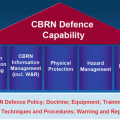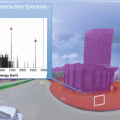© Springer Science+Business Media Dordrecht 2015
Samuel Apikyan and David Diamond (eds.)Nuclear Threats and Security ChallengesNATO Science for Peace and Security Series B: Physics and Biophysics10.1007/978-94-017-9894-5_1414. Nuclear Security Regulation in the United States: An Overview of U.S. NRC Functions and Activities
(1)
Nuclear Regulatory Commission, Washington, DC, USA
Abstract
The United States Nuclear Regulatory Commission (NRC) was created as an independent agency by the United States Congress in 1974 to ensure the safe use of radioactive materials for beneficial civilian purposes. Both the Atomic Energy Act of 1954 and the Energy Reorganization Act of 1974 give the NRC the responsibility for ensuring that the peaceful uses of nuclear energy “make the maximum contribution to the common defense and security and the national welfare.” To achieve these ends, the NRC regulates commercial nuclear power plants and other uses of nuclear materials through licensing, inspection and enforcement of its requirements. These requirements are based on U.S. administrative law. In the field of nuclear security, the NRC regulates the following aspects of nuclear power plant activity: Physical Security; Access Authorization; Access Control; Security Equipment; Protective Strategy; Security Training; and Fitness for Duty. This paper will give an overview of the U.S. NRC security related regulatory functions and activities and explain how the NRC achieves its mission of “promoting the common defense and security” specifically as it relates to nuclear reactors.
Keywords
Nuclear securityNuclear regulationNRC14.1 Atomic Energy: From War to Peace
July 1945 inaugurated a new era in warfare. The first test of a nuclear weapon (code named “Trinity”) was conducted in New Mexico. The development of nuclear weapons was a strictly guarded military secret for the United Sates. After World War II, the knowledge of the destructive potential of nuclear energy was all too apparent.
Soon after, a debate began in the United States between the military and civilian authorities over the control of this technology. Numerous hearings were held in Congress which resulted in Senator Brien McMahon (D-Connecticut) introducing a bill on December 20, 1945 that placed the control of the nation’s atomic energy program in civilian hands. President Truman signed the McMahon Act, known officially as the Atomic Energy Act of 1946, on August 1, 1946. With this law a new civilian agency, the United States Atomic Energy Commission (AEC), was created.1
The Atomic Energy Act of 1946 stated that “the significance of the atomic bomb for military purposes is evident. The effect of the use of atomic energy for civilian purposes upon the social, economic, and political structures of today cannot now be determined”.2
With this focus on the military uses of nuclear power the Act did not allow for the private use of nuclear material. Instead, the Act’s purpose included a program of federally conducted research and development to assure the Government of adequate scientific and technical accomplishment and a program for Government control of the production, ownership, and use of fissionable material to assure the common defense and security.3
By 1953 the realities of the Cold War were becoming evident. Both the United States (U.S.) and the Union of Soviet Socialist Republics (USSR) had tested numerous atomic weapons. While meeting with the leaders of the United Kingdom and France in Bermuda on December 4, 1953, U.S. president Dwight D. Eisenhower stated the world was in a rather hysterical condition about the atomic bomb.4 Eisenhower had been invited by the United Nations to give a speech at their General Assembly and wanted to discuss an idea addressing this concern.
The declassified minutes of that meeting have Eisenhower continuing with his idea that he felt something might be said which, while admitting the terrible destructive quality of atomic energy, might express the point of view of the free world on the constructive capabilities of atomic energy.5 Four days later, Eisenhower gave an address to the General Assembly of the United Nations in New York City. The subject was the “Peaceful Uses of Atomic Energy”. Also known as the “Atoms for Peace” speech, Eisenhower presented a framework for harnessing the peaceful use of nuclear power:
The United States would seek more than the mere reduction or elimination of atomic materials for military purposes.
It is not enough to take this weapon out of the hands of the soldiers. It must be put into the hands of those who will know how to strip its military casing and adapt it to the arts of peace.
The United States knows that if the fearful trend of atomic military buildup can be reversed, this greatest of destructive forces can be developed into a great boon, for the benefit of all mankind.
The United States knows that peaceful power from atomic energy is no dream of the future. That capability, already proved, is here – now – today. Who can doubt, if the entire body of the world’s scientists and engineers had adequate amounts of fissionable material with which to test and develop their ideas, that this capability would rapidly be transformed into universal, efficient, and economic usage.6
Although appearing altruistic, the facts behind sharing nuclear knowledge have to be viewed through the strategic realities of the Cold War. The prevailing sense of urgency, at least among U.S. Government leaders, reflected the fear of falling behind other nations in fostering peaceful atomic progress. The strides that Great Britain was making in the field seemed disturbing enough, but the possibility that the USSR might surpass the United States in civilian power development was even more ominous. AEC Commissioner Thomas E. Murray described a “nuclear power race” in a 1953 speech and warned that the “stakes are high”.7
In order to shift the emphasis of atomic energy from military to peaceful uses, United States law needed to be changed. The Atomic Energy Act of 1946 with its focus on military use and government control of nuclear information and materials was amended. The resulting legislation, the Atomic Energy Act of 1954 (the Act), was signed by President Eisenhower on August 30, 1954. In his statement upon signing the new law, Eisenhower said, “As I sign this bill, I am confident that it will advance both public and private development of atomic energy – that it will thus lead to greater national strength – and that programs undertaken as a result of this new law will help us progress”.8
The goal of the Act was:
Atomic energy is capable of application for peaceful as well as military purposes. It is therefore declared to be the policy of the United States that the development, use, and control of atomic energy shall be directed so as to make the maximum contribution to the general welfare, subject at all times to the paramount objective of making the maximum contribution to the common defense and security; and the development, use, and control of atomic energy shall be directed so as to promote world peace, improve the general welfare, increase the standard of living, and strengthen free competition in private enterprise.9
The Act instructed the AEC to prepare regulations that would protect public health and safety from radiation hazards. Thus, it assigned the agency three major functions: (1) to continue its weapons program, (2) to promote the commercial uses of nuclear power, and (3) to protect against the hazards of those peaceful applications.10
14.2 New Agencies: NRC & DoE
As time went on the three competing AEC functions became increasingly difficult to manage. The AEC came under attack for the conflicting responsibilities of promoting the development of civilian nuclear power and regulating the same. After the energy crisis of the early 1970s, then President Richard Nixon asked the U.S. Congress to create a new agency whose only responsibility was to regulate and license the commercial use of nuclear material.
In 1974 the U.S. Congress passed the Energy Reorganization Act which eliminated the Atomic Energy Commission and created the Nuclear Regulatory Commission (NRC) and the Energy Research and Development Agency (ERDA). The NRC was created to regulate the commercial nuclear industry while ERDA managed nuclear research, development, nuclear weapons and naval reactors. Two years later, in 1977, ERDA was merged with several other agencies to create the U.S. Department of Energy.11
14.3 Legal Basis for NRC Activities
So far we have discussed the history of the Nuclear Regulatory Commission. Now we turn to the legal basis for the civilian control of nuclear material in the United States.
The U.S. Constitution organized the federal government into three branches: Article 1: Legislative (Congress); Article 2: Executive (President); Article 3: Judiciary (Courts). Each branch of government can make laws. The legislative branch creates statutory law; the executive branch creates regulatory law; and the judicial branch creates common law.
As we have seen, the fundamental law establishing the creation and purpose of the NRC is the Atomic Energy Act of 1954. Since the U.S. Congress created this law it is considered a statute. However, through the years since its first implementation, the Act has been amended numerous times. Therefore in legal documents we refer to the Act as “The Atomic Energy Act of 1954, as amended”.
The second important law that affects the NRC is the Energy Reorganization Act of 1974 which created the NRC and specified its functions in relation to control of civilian use of nuclear material.12 The Reorganization Act sates that:
There is established an independent regulatory commission to be known as the Nuclear Regulatory Commission which shall be composed of five members, each of whom shall be a citizen of the United States… Members of the Commission shall be appointed by the President, by and with the advice and consent of the Senate… Appointments of members pursuant to this subsection shall be made in such a manner that not more than three members of the Commission shall be members of the same political party. Each member shall serve for a term of five years…13
As a result, the NRC is an independent agency by virtue of the Reorganization Act. It does not belong to any other department in the federal government. The NRC is part of the executive branch insofar as the president appoints the commissioners. However, the Reorganization Act states that any commissioner may be removed by the President only for inefficiency, neglect of duty, or malfeasance in office.14 This establishes both the independence of the NRC and its executive agency status.
Stay updated, free articles. Join our Telegram channel

Full access? Get Clinical Tree






